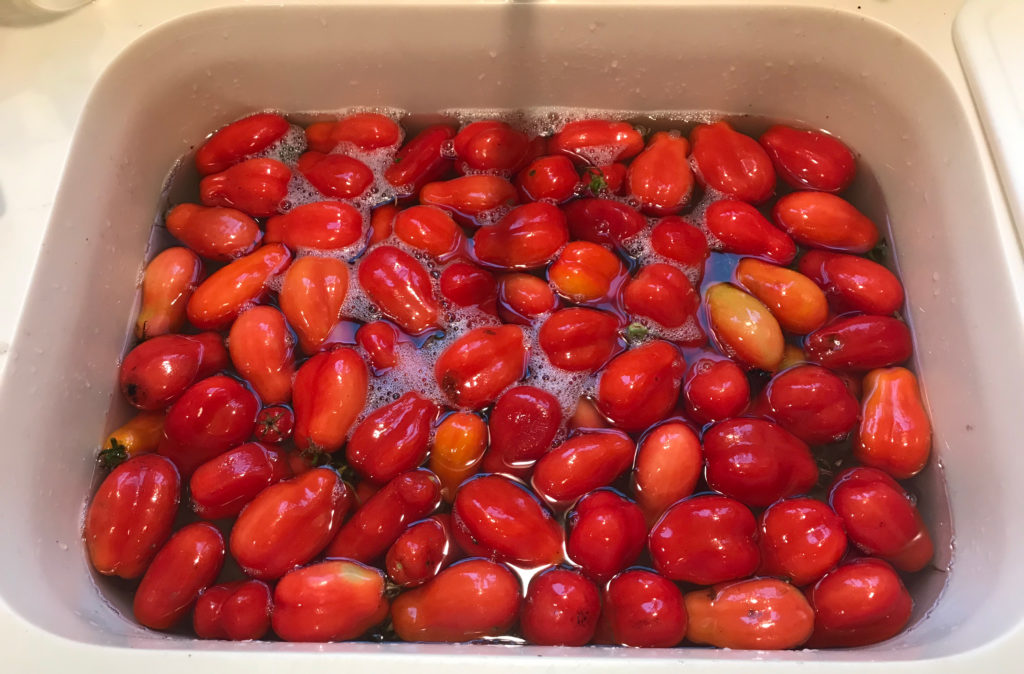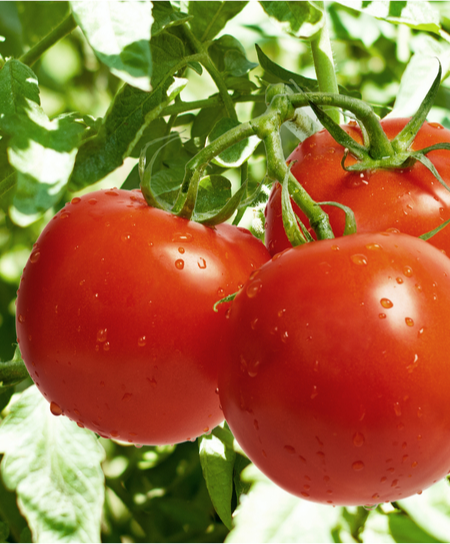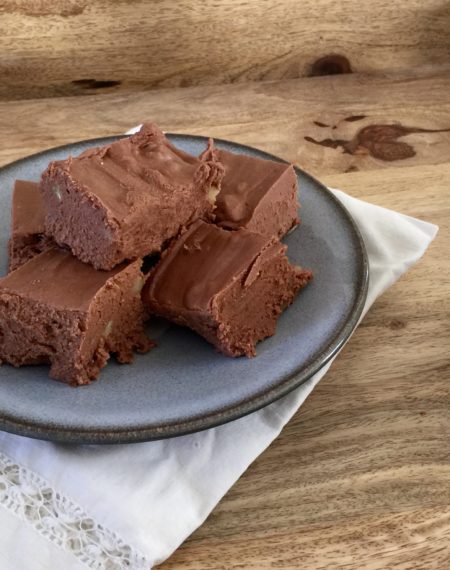One of the things I inherited from my grandmother was a very large black and white speckled pot with a lid. Inside, it had a rusted wire thing that I really wasn’t sure why it was in there – I assumed someone had held that wire thing and decided storing it in a pot was the best idea on a moving day. I believe it’s made of enameled steel – the speckled cookware that was so popular in the early to middle part of the twentieth century – and has made a comeback at times. The Pioneer Woman has her own line that Good Housekeeping calls “nostalgic.”

I’ve seen some people call this Granitewear – it’s lighter than a cast iron witch’s pot and clearly durable considering that I’ve been using it a lot in my kitchen, three generations later.
Canning tomatoes and botulism
At Tante Anna, my sister and I love trying to recreate the good things from our past into our every day, often prompted by memories. Whenever June berries are ripe or early garden vegetables in July, past visions of summertime jump into my head.
As children, we spent several summers helping our mother, grandmother and aunt on canning days. I remember my grandparents’ house was bustling with my younger cousins and little sisters playing games that had them running inside and outside. I also remember my dad, uncle and grandfather helping, but the person in charge was definitely my grandmother who designed her basement to be lined with built-in cabinets my grandfather had custom created for her canned vegetables and fruits. These cabinets had narrow ledges and lined almost one entire side of the finished basement. At first appearance, they appeared so shallow and long that they disappeared as part of the wall. Even in winter, the shelves seemed to be always filled with blue Bell or Kerr brand jars of peeled whole tomatoes. I’m sure there were pickles and jams too, but there were a LOT of tomatoes.

About eleven years ago, my mom helped me can grape jelly from my Concord grape vines. We thought we could get away without using pectin, but the jelly was more like syrup as a result. We had plans to do better the following year, but hadn’t the chance.
More than a decade later, I thought I’d give canning a try once more. While I know memories can’t retain all the details needed for a step-by-step process, I was pretty certain I could can on my own – I mean isn’t that how my grandmother learned, from helping her mother? I figured that if my grandmother had successfully put up cans of preserved food every year, so could I! How hard could it be when there are YouTube channels and numerous blogs devoted to home preserving?
And you know what, it was a pretty simple process. I started with a batch of bumper Danish strawberries this June and knew that if I didn’t get them into jam jars, they’d rot before we could eat them all. It was learn to can today, or cry over the moldy red berries tomorrow.
When the end of August rolled around, I had another bumper crop – this time San Marzano tomatoes – and from a single plant. Mother’s Day set this whole thing in motion. Our neighborhood pub (sounds so British saying, but I swear, they serve beer and chips!) George and the Dragon has a lovely Mother’s Day Brunch where, instead of a cliché rose, moms walk out of George and the Dragon with a lovely tomato seedling – perfect timing to drop into a Minnesota garden in early May.
I had stuck this year’s plant into the ground in a bed raised two feet from the ground (damn rabbits, I know you were you live) and these plum sized tomatoes were more fertile than bunnies.

I’ve been reading the fourth book of Outlander, Drums of Autumn, where time traveler Claire muses that she still has time for a late fall harvest of cabbage which she plans to preserve with the intent to keep her family eating greens through the winter. While she’s not really canning the cabbage, she’s storing them in some kind of crockery in her pantry. As her inner dialogue reveals, she wonders if this food storage method will be safe from botulism, but then decides she’s been careful enough. If twentieth-century trained Doctor Claire doesn’t worry, why should I?
My strawberry canning was a great success as just a day ago, I’d opened up a recent jar from the shelf and slathering it on toast for my precious child. When reading over the Bell instructions on canning fruits, it notes that berries and tomatoes weren’t at risk for botulism due to their high acidity. Cool. Add the sugar, boil them in their water bath and ensure the middle part of the lid isn’t poppable. The instructions added that low acidity foods, like meats and beans, need a pressure cooker.

Remembering my grandmother’s tomato canning days, I don’t remember a pressure cooker.
What could go wrong with making health choices based on childhood memories and a fictional surgeon’s internal musings on botulism risks in the eighteenth century? If you happen to be someone who thinks it’s perfectly normal to base your canning process from a scene in a novel, well, let’s just say I think we will be friends.
HOW TO NOT KILL YOUR FRIENDS AND FAMILY
When you look at canning recipes from reputable sources (I did), they remind you that a boiling water bath works for high acidity foods like berries and tomatoes. With this knowledge, I brought in a bushel of tomatoes (no idea if this is an exact bushel-full, I’m not terribly keen on exact measurements) and started my September canning day.
Instead of just canning the tomatoes like my grandmother, I thought it would be terribly clever of me to make a large batch of tomato sauce and can that instead. So I did.

And I was so proud of myself. I’d set aside four large jars for this winter. I vaguely remember Barbara Kingsolver doing the same thing in her Animal, Vegetable, Miracle book. She had shelves built to store her canned goods. Authors know so much, right?
Before I went to bed, I dove a bit into the ‘canning lifestyle’ a deep online web that shares homesteading, farming, hobby gardening…I went all in and read and read, feeling like I was one with this new community that included people like Barbara Kingsolver, Martha Stewart and this guy.
But then came the warnings. Like
- Garlic has Low Acidity
- Olive Oil has VERY low acidity
- ONLY Used TESTED Canning Recipes
- Botulism KILLS
Whoa…wait, it kills? I just thought it was a nasty stomach bacterium that would have you wrapped around your toilet for 24 hours. My mind raced to:
1. That sauce has a lot of garlic
2. I abuse olive oil
3. Like most cooking sauces, I totally made this one up on the fly with whatever ingredients I had on hand
4. I’ll be a murderer (murderess?) soon (sing it to this song and it’s even creepier)
As midnight approached, I was accessing FoodandDrug.gov and university extension sites across the country. I started downloading research articles from scientific journals. One university science professor said, “when in doubt, throw it out.” My over exhausted brain was racing and after I finally shut down the dark web of paranoia, I went upstairs and fell asleep exhausted.
Jolted awake only minutes later, I knew I’d been having a nightmare of my family spurting blood or falling off cliffs or other horrid imaginings and knew it would be me who did it in the kitchen, with a Kerr jar. Then, I remembered Jane Smiley. She’s got a bit of an evil streak in her. Remember Ginny (aka Goneril) from A Thousand Acres who tried to poison her sister Rose (Regan) with canned sausages? That conjurer Smiley summoned me when she wrote in Regan’s character.
I’d have to throw the whole lot out. My head settled some and I fell into black sleep.
But, then, next morning, after some coffee and before I threw out my canned sauces, I came across one of the CDC articles I’d found.
Botulism thrives in airless, low-acid environments. So, if the heat from bath canning won’t kill it in an air-tight jar, the heat from a 10-minute boil on the stovetop would kill any spores that bubbled to the air surface.
With just one cup of caffeine, I saved my family.
 The humble casserole: a history of our beloved hot dish
The humble casserole: a history of our beloved hot dish In Honor of National Banana Bread Day (yes, this is a thing), Feb. 23
In Honor of National Banana Bread Day (yes, this is a thing), Feb. 23 Mother’s Day Mistake and the Serendipity of George and the Dragon’s Tomato Seedlings.
Mother’s Day Mistake and the Serendipity of George and the Dragon’s Tomato Seedlings. The History of Blunder
The History of Blunder
